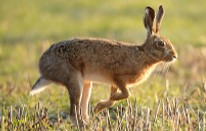Nature Notes – February 2022
by Andy Johnson
 Walking along Fleetham Lane on New Year’s Day I was surprised to see four hares cavorting around showing signs of mating. Normally hares breed from early spring into autumn. Ancient Britons regarded them as magical and they were associated with spring rejuvenation and the moon. Hares spend much of their day in woodland, except in the breeding season when they emerge into arable fields and grassland where they create their “forms” and give birth to leverets.
Walking along Fleetham Lane on New Year’s Day I was surprised to see four hares cavorting around showing signs of mating. Normally hares breed from early spring into autumn. Ancient Britons regarded them as magical and they were associated with spring rejuvenation and the moon. Hares spend much of their day in woodland, except in the breeding season when they emerge into arable fields and grassland where they create their “forms” and give birth to leverets.
Although there has been a huge reduction in hare numbers nationally, we have a good local population, and last June I counted 13 near the Swale. Hares can damage young trees and shrubs and in the past “hare drives” reduced their numbers. A local farmer recounted that as a boy he was at one drive which took place between Morton Bridge and Far Fairholme. The farmers, workers, boys and dogs ‘beat’ a large area and drove the hares towards a loop in the Swale, thus enclosing them. Today the biggest danger to hares, other than foxes and badgers, are poachers and illegal hare coursing.
